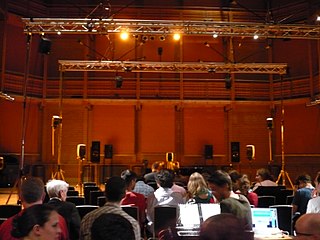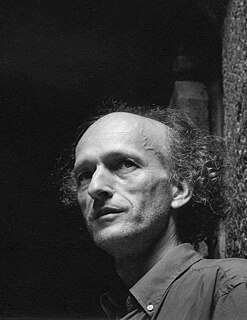Related Research Articles
Electronic music is music that employs electronic musical instruments, digital instruments and circuitry-based music technology. In general, a distinction can be made between sound produced using electromechanical means, and that produced using electronics only. Electromechanical instruments include mechanical elements, such as strings, hammers, and so on, and electric elements, such as magnetic pickups, power amplifiers and loudspeakers. Examples of electromechanical sound producing devices include the telharmonium, Hammond organ, and the electric guitar, which are typically made loud enough for performers and audiences to hear with an instrument amplifier and speaker cabinet. Pure electronic instruments do not have vibrating strings, hammers, or other sound-producing mechanisms. Devices such as the theremin, synthesizer, and computer can produce electronic sounds.
Musique concrète is a type of music composition that utilizes recorded sounds as raw material. Sounds are often modified through the application of audio effects and tape manipulation techniques, and may be assembled into a form of montage. It can feature sounds derived from recordings of musical instruments, the human voice, and the natural environment as well as those created using synthesizers and computer-based digital signal processing. Compositions in this idiom are not restricted to the normal musical rules of melody, harmony, rhythm, metre, and so on. It exploits acousmatic listening, meaning sound identities can often be intentionally obscured or appear unconnected to their source cause.

Musical composition, music composition, or simply composition, can refer to an original piece or work of music, either vocal or instrumental, the structure of a musical piece, or to the process of creating or writing a new piece of music. People who create new compositions are called composers. Composers of primarily songs are usually called songwriters; with songs, the person who writes lyrics for a song is the lyricist. In many cultures, including Western classical music, the act of composing typically includes the creation of music notation, such as a sheet music "score," which is then performed by the composer or by other musicians. In popular music and traditional music, songwriting may involve the creation of a basic outline of the song, called the lead sheet, which sets out the melody, lyrics and chord progression. In classical music, orchestration is typically done by the composer, but in musical theatre and in pop music, songwriters may hire an arranger to do the orchestration. In some cases, a pop or traditional songwriter may not use written notation at all, and instead compose the song in their mind and then play, sing or record it from memory. In jazz and popular music, notable sound recordings by influential performers are given the weight that written or printed scores play in classical music.

A composer is a musician who is an author of music in any form, including vocal music, instrumental music, electronic music, and music which combines multiple forms. A composer may create music in any music genre, including, for example, classical music, musical theatre, blues, folk music, jazz, and popular music. Composers often express their works in a written musical score using musical notation.

IRCAM is a French institute for science about music and sound and avant garde electro-acoustical art music. It is situated next to, and is organisationally linked with, the Centre Georges Pompidou in Paris. The extension of the building was designed by Renzo Piano and Richard Rogers. Much of the institute is located underground, beneath the fountain to the east of the buildings.
Electroacoustic music is a genre of Western art music in which composers use technology to manipulate the timbres of acoustic sounds, sometimes by using audio signal processing, such as reverb or harmonizing, on acoustical instruments.(Staff n.d.) It originated around the middle of the 20th century, following the incorporation of electric sound production into compositional practice. The initial developments in electroacoustic music composition to fixed media during the 20th century are associated with the activities of the Groupe de Recherches Musicales at the ORTF in Paris, the home of musique concrète, the Nordwestdeutscher Rundfunk (NWDR) studio in Cologne, where the focus was on the composition of elektronische Musik, and the Columbia-Princeton Electronic Music Center in New York City, where tape music, electronic music, and computer music were all explored. Practical electronic music instruments began to appear in the early 1900s.
In electronic music theory and electronic composition theory a sound object (coined by Pierre Schaeffer)1 corresponds with a primary unit of music such that could be played on an instrument or sung by a vocalist. A sound object specifically refers to recorded sound rather than music written using manuscript or a score. More precisely, in his book Traité des objets musicaux Schaeffer considers the sound object in these terms:
This unit of sound [sound object] is the equivalent to a unit of breath or articulation, a unit of instrumental gesture. The sound object is therefore an acoustic action and intention of listening.
Acousmatic music is a form of electroacoustic music that is specifically composed for presentation using speakers, as opposed to a live performance. It stems from a compositional tradition that dates back to the introduction of musique concrète in the late 1940s. Unlike musical works that are realised using sheet music exclusively, compositions that are purely acousmatic often exist solely as fixed media audio recordings.
Jonathan Dean Harvey was a British composer. He held teaching positions at universities and music conservatories in Europe and the USA and was frequently invited to teach in summer schools around the world.
Denis Arthur Smalley is a composer of electroacoustic music, with a special interest in acousmatic music.

Wave field synthesis (WFS) is a spatial audio rendering technique, characterized by creation of virtual acoustic environments. It produces artificial wavefronts synthesized by a large number of individually driven loudspeakers. Such wavefronts seem to originate from a virtual starting point, the virtual source or notional source. Contrary to traditional spatialization techniques such as stereo or surround sound, the localization of virtual sources in WFS does not depend on or change with the listener's position.

Donnacha Dennehy is an Irish composer.

Birmingham ElectroAcoustic Sound Theatre, or as it is more commonly known, BEAST, is a sound diffusion system specifically designed for the performance of electroacoustic music. It is a long-running project of the Electroacoustic Music Studios at the University of Birmingham, founded in 1982 under the directorship of Jonty Harrison. Since 2014 BEAST has been directed by Scott Wilson, along with Annie Mahtani and James Carpenter as technical director. Simply put, it consists of a set of loudspeakers connected to a computer, usually controlled by a diffusion console.

The Acousmonium is the sound diffusion system designed in 1974 by Francois Bayle and used originally by the Groupe de Recherches Musicales at the Maison de Radio France. It consists of 80 loudspeakers of differing size and shape, and was designed for tape playback. As Bayle wrote in a CD sleeve note in 1993, it was
Another utopia, devoted to pure "listening" … as a penetrable "projection area", arranged with a view to immersion in sound, to spatialised polyphony, which is articulated and directed.
Répons is a composition by French composer Pierre Boulez for a large chamber orchestra with six percussion soloists and live electronics. The six soloists play harp, cimbalom, vibraphone, glockenspiel/xylophone, and two pianos. It was premiered on 18 October 1981 at the Donaueschingen Festival. The composer expanded it until its completion in 1985. The work is dedicated to Alfred Schlee "on his 80th birthday".
Live electronic music is a form of music that can include traditional electronic sound-generating devices, modified electric musical instruments, hacked sound generating technologies, and computers. Initially the practice developed in reaction to sound-based composition for fixed media such as musique concrète, electronic music and early computer music. Musical improvisation often plays a large role in the performance of this music. The timbres of various sounds may be transformed extensively using devices such as amplifiers, filters, ring modulators and other forms of circuitry. Real-time generation and manipulation of audio using live coding is now commonplace.

Denis Dufour is a composer of serious music.
The Acousmatic Room Orchestration System (AROS) is a multichannel sound system design for the playback of sound and music using a multitude of speakers.
Thierry Blondeau is a French composer.
Barry Anderson, was a New Zealand-born composer, teacher, and pioneer in the dissemination of electroacoustic music in the United Kingdom. Internationally, his best known work is his realisation of the electronic music for Harrison Harrison Birtwistle's opera The Mask of Orpheus.
References
- ↑ Austin, Larry (2000). "Sound Diffusion in Composition and Performance: An Interview with Denis Smalley". Computer Music Journal. 24 (2): 10–21.
- ↑ Emmerson, Simon (2007)."Living Electronic Music", Aldershot, Hants: Ashgate. ISBN 978-0-7546-5546-6
- ↑ Bates, Enda (2009). The Composition and Performance of Spatial Music. Dublin: Trinity College. p. 150.
- ↑ Bates, Enda (2009). The Composition and Performance of Spatial Music. Dublin: Trinity College.